Starting a new business can be a daunting task unless you have a steady plan to keep you in track. While many players have entered the eCommerce market, few have gotten it right. While the advantage of starting early in the segment is lost, there’s an advantage of harnessing many new gen technologies and lessons from failed and successful eCommerce companies. Every eCommerce site needs to have its own USP so that customers have a reason to go to the website. This has to be something other than just lower prices since that can’t be sustainable in the long run although it’s a crucial factor when it comes to staying competitive. Here’s how to build an ecommerce website step-by-step.
How to Build an Ecommerce Website – Steps
Although a document cannot exactly help you plan your path to building an eCommerce website, we have set the basic framework and checklist that every eCommerce site must follow no matter what the niche, or which region it is offering its services in.
Getting started is a laborious task in itself, but not if you have chalked it out. Here’s how to build an ecommerce website.
Plan Ahead
It is very important to plan ahead. Decide what you want to sell, and which niche products you want to cover, and what unique features you want to offer, ahead of deployment, so that you do not have to retrace your steps later on. Having a blueprint ensures that you have a written document to follow, where you can tick off on each step that is completed and each incomplete one will stare at you, thus creating urgency in your mind.
Get your suppliers
What would you sell if you have no suppliers? Set your supplier onboarding strategy in the very beginning and try to build a partnership with companies who are in it for the long run. This would be beneficial for both parties as well as for customers who would hate to see some products disappearing suddenly due to termination of supplier contracts.
Put together your teams
Recruitment is a tough job in the age of high attrition rates. That’s why like onboarding your suppliers, it is just as important to find and add to your team, not just the best minds, but also those who believe in your ideas and are in it for the long haul.
Set up your infrastructure
While most companies use AWS, or other cloud services for setting up their servers and saving backups and logs, whether you are setting up in-situ servers or you are renting it in the cloud, the infrastructure setup takes some time to get right, and it is better, that you have a DevOps team to handle it, in case your team lacks extensive infra knowledge.
Create a warehouse strategy
In the time of “next day” and “same day” deliveries, it is important, that you have strategically place warehouses in big metro cities throughout a country so that you can provide fast deliveries in urban areas and also have faster deliveries to nearby towns. Spreading warehouses evenly would also help you make sure that most locations are always within a 2day or 3day reach. This is a step on how to build an ecommerce website.
Plan on delivery partner tie-ups
Along with the warehouse placement strategy, it would be vital to decide on which delivery partners you would want to work with. The decision would depend on your product sizes, material, weights, the partner’s per Kg B2C rates, and more. No matter what you are selling, unless you have an excellent last mile delivery strategy, people will not be happy- that’s what makes this one of the most important factors to keep in mind when setting up your eCommerce website.
Decide on SEO and marketing strategy
Search engine optimisation can help bring more organic customers. A good online marketing strategy can help bring in more targeted customers and can be a huge factor in your overall growth. A perfect balance between the two would help you grow your sales while keeping marketing costs low, in the long run.
Get your focus right
With so much going on, competitors getting early funding, and new problems coming up every day, it is easy to lose focus. But if you want to create a sustainable eCommerce platform, getting your focus right from day one is an absolute must.
Decide your niche, and design accordingly
Your website needs to be very different depending on what you are trying to sell. If you are selling electronic goods, mentioning the specs in details is important, if you are selling industrial goods, it is important that you upload videos of the machines and equipment that you are selling; if you are selling perfumes, you might want to send miniature samples of your best products, whenever someone orders something on your website, and so on. Your website has to be custom build so that customers automatically feel that yes, they are on a website that caters to the category of products, that you are trying to sell.
Build the database structure taking into account future changes
Whether you host it on the cloud or in your own private servers, the database is one of the most important factors for an eCommerce website. Make sure that you always have a copy of the entire database in a different location, and that it is synchronised every day. While designing the tables on the database, it is always wise to keep a few columns extra for future use, in case you need to insert something like different tax rates, or the number of pieces in a box, etc.
Focus on customer experience
There are some websites that focus heavily on customer experience and those are the ones that make us feel at home when we are browsing products. Certain design structures for websites, such as the new card layout, are a hit, and people find it easier to interact with a website with simpler designs. Keeping it minimalistic is also important so that first-time users don’t need a guided tour and every button or link explains its own purpose. De-cluttering is the way to go when it comes to modern era website designs.
Make things easier for customers
Every eCommerce site is trying to sell you things. Few are trying to make it easier for the customer to buy something that he needs. Making things easier for the customer can have a multitude of benefits in the long run.
Maintain Inventory Records
No customer likes to order something and then be told that the product is out of stock. Make sure that you keep track of inventory and display the number of items in stock for every product page. Items with lesser inventory figures would, in turn, drive sales by creating a sense of urgency. Along with it, also accept e-mail request to get products that are out of stock, through customised processes.
Show better shipping estimates and tracking
Shipping estimates count a lot towards customer satisfaction. If I order a book on Tuesday, and your site says that it will be delivered on Saturday, I might get it delivered to my home, thinking that I’ll be at home on Saturday. But then if you send it late, on Monday, or early, on Friday, it would be a logistic issue for me, as well as a headache. Try making the delivery estimates and package tracking better, so that customers can get their packages in their preferred time. As website monitoring is important in order to gauge customer experience and improve quickly.
Minimise product returns
Having bigger descriptions, product reviews, product videos, differences with similar products, and how-to-use manuals, on every product page might seem difficult to set up initially, but the benefits on that would be long-lasting. Not only are customers more likely to return items less if everything is openly declared on the website, but it would also create a better customer service experience.
Automate Customer Service to a certain extent
You could have 10 customer care executives. You could hire 100. You could even get 1000. None of the numbers is future proof. What you could instead do is automate the customer service, so that things like item tracking, defective item report, help with item ordering, which can be taken care of by a system, are easier to provide and faster to use for customers. This would also keep your operational costs low.
Track competitor prices using Web Scraping
Ecommerce is an extremely competitive space where brands battle each other in price wars. Competitive pricing is a huge driver for Ecommerce sales. Almost all Ecommerce brands, big or small take the help of price monitoring services to stay relevant in the game. If you aren’t making use of a price scraping system, you are literally leaving money on the table and losing out to your competition. Partnering with a reliable web scraping service provider can take care of your price data extraction needs and help keep your offerings competitive.
Above all, be a brand, not a website
When I say be a brand, not a website, you might ask, “Why?”. Well, I can explain that with an example. Let’s take the case of Nokia. Nokia’s Windows phones were a failure, but before that, it had been a success for many years. In fact, there was a time when cell-phones and Nokia were synonyms. Nokia was still a website selling mobile phones, but it became more than that- it became a brand. So people still remembered it after it went down, and when it came back in 2017, it grabbed a huge chunk of the market at one go. That’s because people still had belief in the brand name. Now, you have learned how to build an ecommerce website.
When you build a website, an eCommerce site, the most you could do is be a great eCommerce site and provide an amazing experience. But that many could replicate. Instead, you could become a brand. Have workshops across the country. Display your products at events, and tech-company meets, or even organise your own events, sponsor charity functions, and more. Once you can get your name across the road, as a brand, and build people’s faith in the brand, you would have built a self-sustainable business model.













